engine TOYOTA AYGO 2012 (in English) Owner's Manual
[x] Cancel search | Manufacturer: TOYOTA, Model Year: 2012, Model line: AYGO, Model: TOYOTA AYGO 2012Pages: 368, PDF Size: 16.94 MB
Page 127 of 368
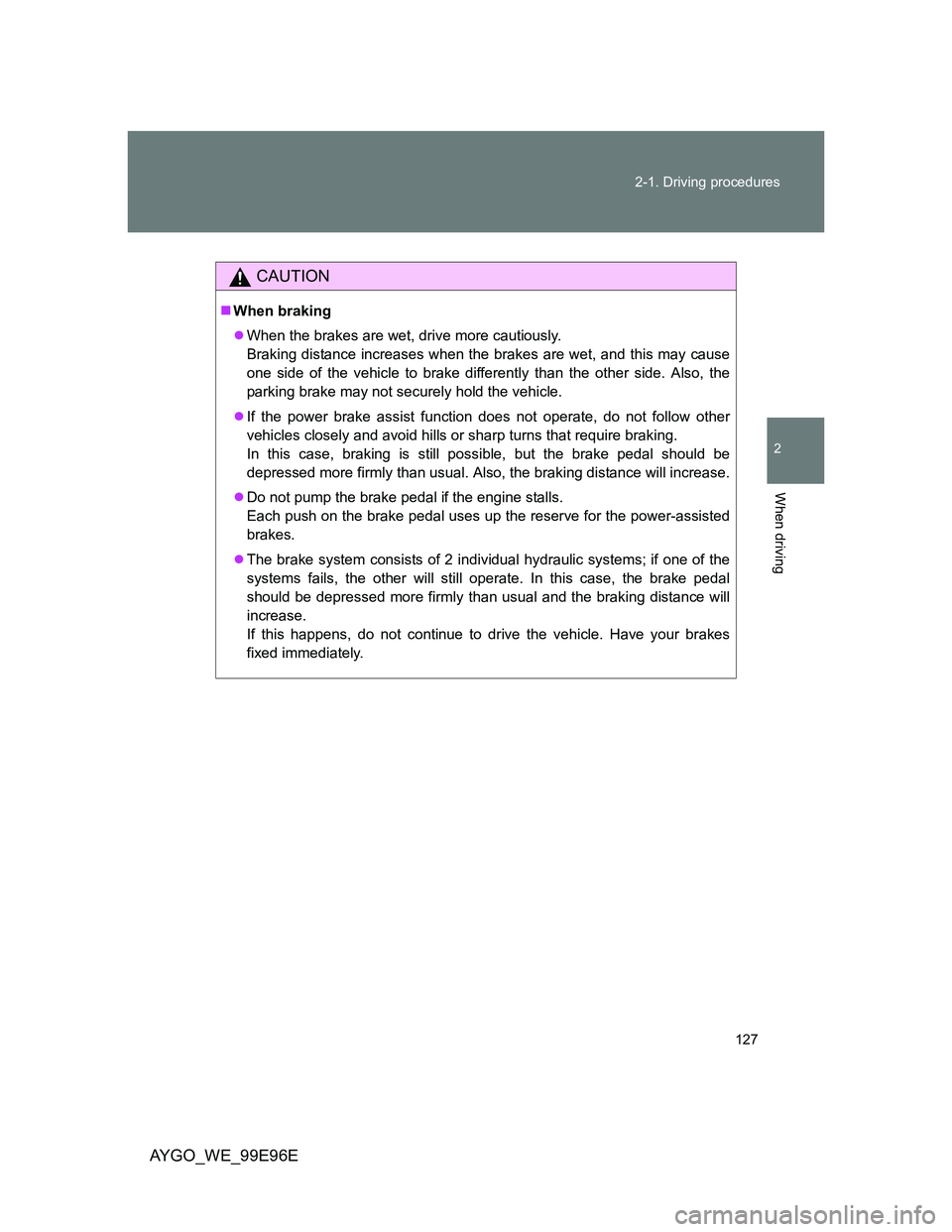
127 2-1. Driving procedures
2
When driving
AYGO_WE_99E96E
CAUTION
When braking
When the brakes are wet, drive more cautiously.
Braking distance increases when the brakes are wet, and this may cause
one side of the vehicle to brake differently than the other side. Also, the
parking brake may not securely hold the vehicle.
If the power brake assist function does not operate, do not follow other
vehicles closely and avoid hills or sharp turns that require braking.
In this case, braking is still possible, but the brake pedal should be
depressed more firmly than usual. Also, the braking distance will increase.
Do not pump the brake pedal if the engine stalls.
Each push on the brake pedal uses up the reserve for the power-assisted
brakes.
The brake system consists of 2 individual hydraulic systems; if one of the
systems fails, the other will still operate. In this case, the brake pedal
should be depressed more firmly than usual and the braking distance will
increase.
If this happens, do not continue to drive the vehicle. Have your brakes
fixed immediately.
Page 129 of 368

129 2-1. Driving procedures
2
When driving
AYGO_WE_99E96E
NOTICE
If you get a flat tire while driving
A flat or damaged tire may cause the following situations. Hold the steering
wheel firmly and gradually depress the brake pedal to slow down the vehicle.
It may be difficult to control your vehicle.
The vehicle will make abnormal sounds or vibrations.
The vehicle will lean abnormally.
Information on what to do in case of a flat tire (P. 318)
When encountering flooded roads
Do not drive on a road that has flooded after heavy rain etc. Doing so may
cause the following serious damage to the vehicle:
Engine stalling
Short in electrical components
Engine damage caused by water immersion
In the event that you drive on a flooded road and the vehicle is flooded, be
sure to have any authorized Toyota dealer or repairer, or another duly quali-
fied and equipped professional check the following:
Brake function
Changes in quantity and quality of engine oil, transmission fluid, etc.
Lubricant condition for the bearings and suspension joints (where possi-
ble), and the function of all joints, bearings, etc.
Page 130 of 368

130
2-1. Driving procedures
AYGO_WE_99E96E
Engine (ignition) switch
Starting the engine
Vehicles with a multi-mode manual transmission
Check that the parking brake is set.
Firmly depress the brake pedal, turn the engine switch to
the “ON” position and shift the shift lever to N. (P. 133)
Turn the engine switch to the “START” position to start the
engine.
Vehicles with a manual transmission
Check that the parking brake is set.
Check that the shift lever is set in N.
Firmly depress the clutch pedal.
Turn the engine switch to the “START” position to start the
engine.
Changing the engine switch positions
“LOCK” position
The steering wheel is locked
and the key can be removed.
“ACC” position
Some electrical components
such as the audio system can
be used.
“ON” position
All electrical components can
be used.
“START” position
For starting the engine.
Page 131 of 368
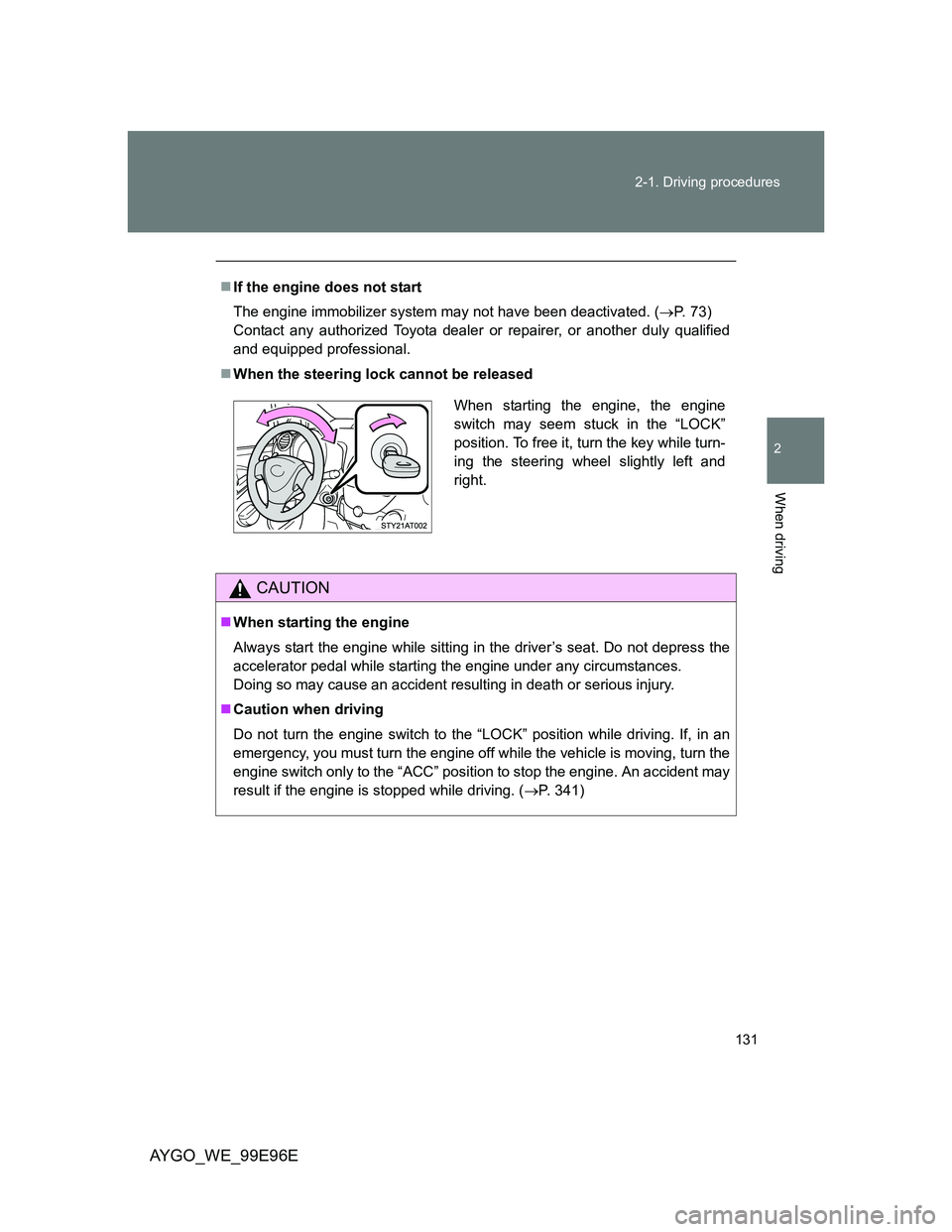
131 2-1. Driving procedures
2
When driving
AYGO_WE_99E96E
If the engine does not start
The engine immobilizer system may not have been deactivated. (P. 73)
Contact any authorized Toyota dealer or repairer, or another duly qualified
and equipped professional.
When the steering lock cannot be released
CAUTION
When starting the engine
Always start the engine while sitting in the driver’s seat. Do not depress the
accelerator pedal while starting the engine under any circumstances.
Doing so may cause an accident resulting in death or serious injury.
Caution when driving
Do not turn the engine switch to the “LOCK” position while driving. If, in an
emergency, you must turn the engine off while the vehicle is moving, turn the
engine switch only to the “ACC” position to stop the engine. An accident may
result if the engine is stopped while driving. (P. 341)
When starting the engine, the engine
switch may seem stuck in the “LOCK”
position. To free it, turn the key while turn-
ing the steering wheel slightly left and
right.
Page 132 of 368
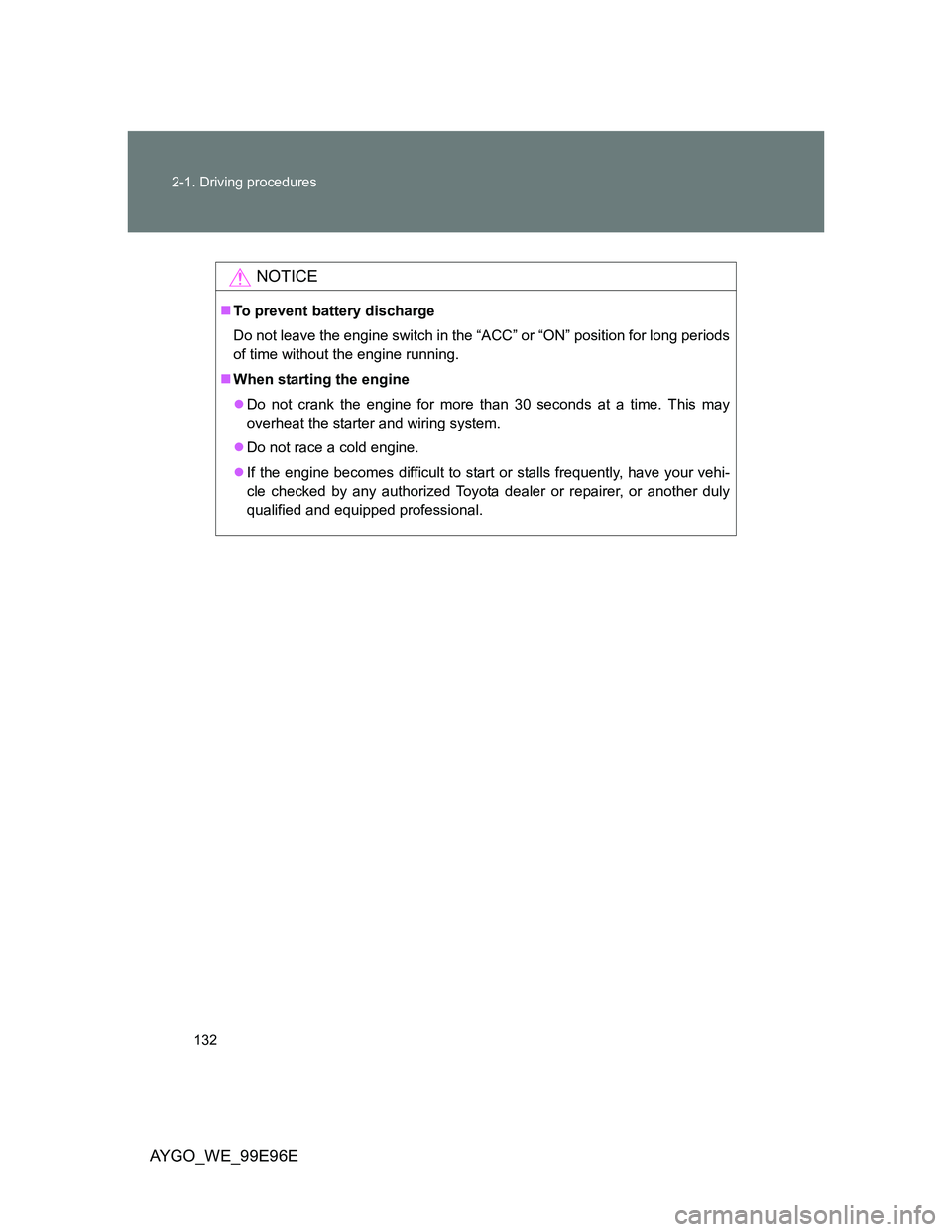
132 2-1. Driving procedures
AYGO_WE_99E96E
NOTICE
To prevent battery discharge
Do not leave the engine switch in the “ACC” or “ON” position for long periods
of time without the engine running.
When starting the engine
Do not crank the engine for more than 30 seconds at a time. This may
overheat the starter and wiring system.
Do not race a cold engine.
If the engine becomes difficult to start or stalls frequently, have your vehi-
cle checked by any authorized Toyota dealer or repairer, or another duly
qualified and equipped professional.
Page 133 of 368
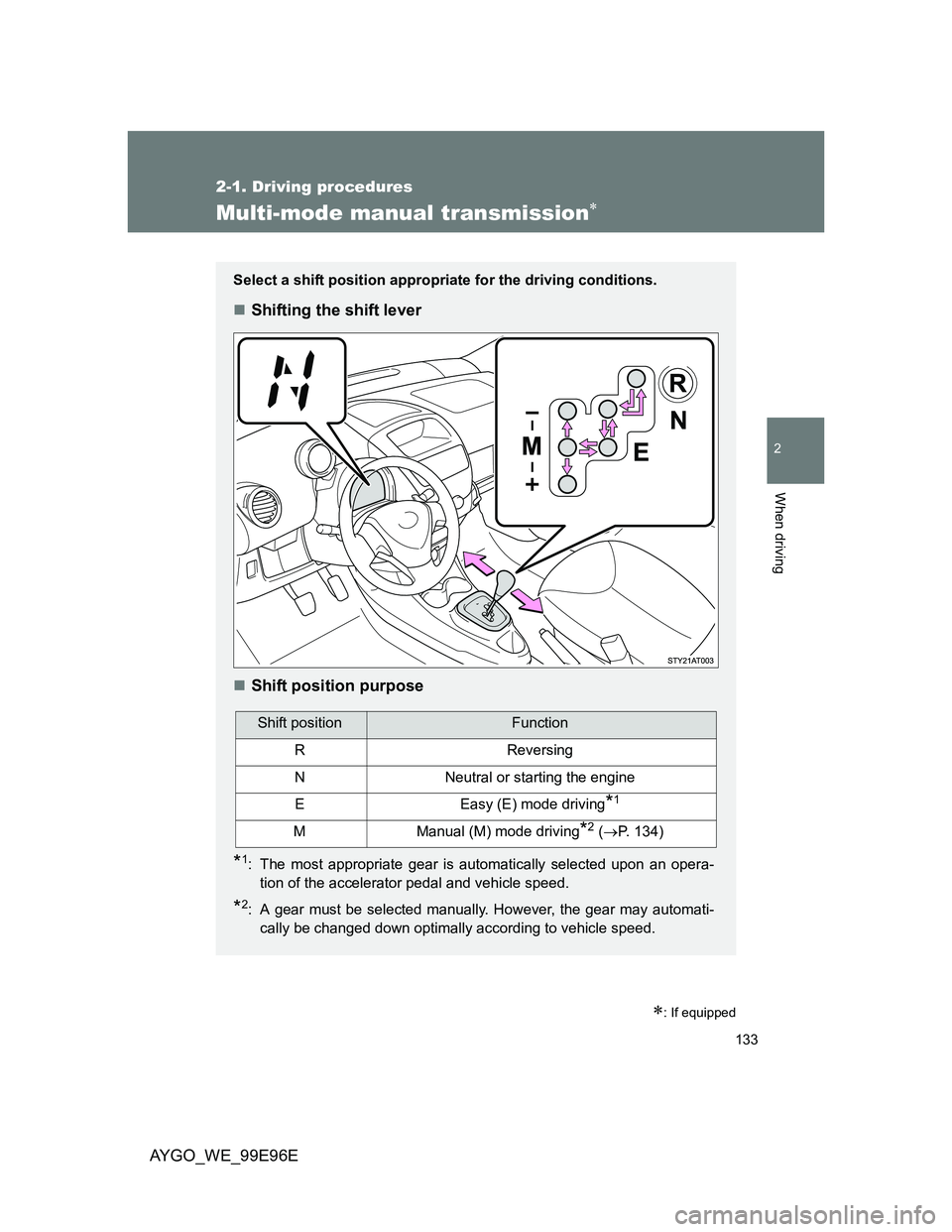
133
2-1. Driving procedures
2
When driving
AYGO_WE_99E96E
Multi-mode manual transmission
: If equipped
Select a shift position appropriate for the driving conditions.
Shifting the shift lever
Shift position purpose
*1: The most appropriate gear is automatically selected upon an opera-
tion of the accelerator pedal and vehicle speed.
*2: A gear must be selected manually. However, the gear may automati-
cally be changed down optimally according to vehicle speed.
Shift positionFunction
RReversing
NNeutral or starting the engine
EEasy (E) mode driving*1
MManual (M) mode driving*2 (P. 134)
Page 136 of 368
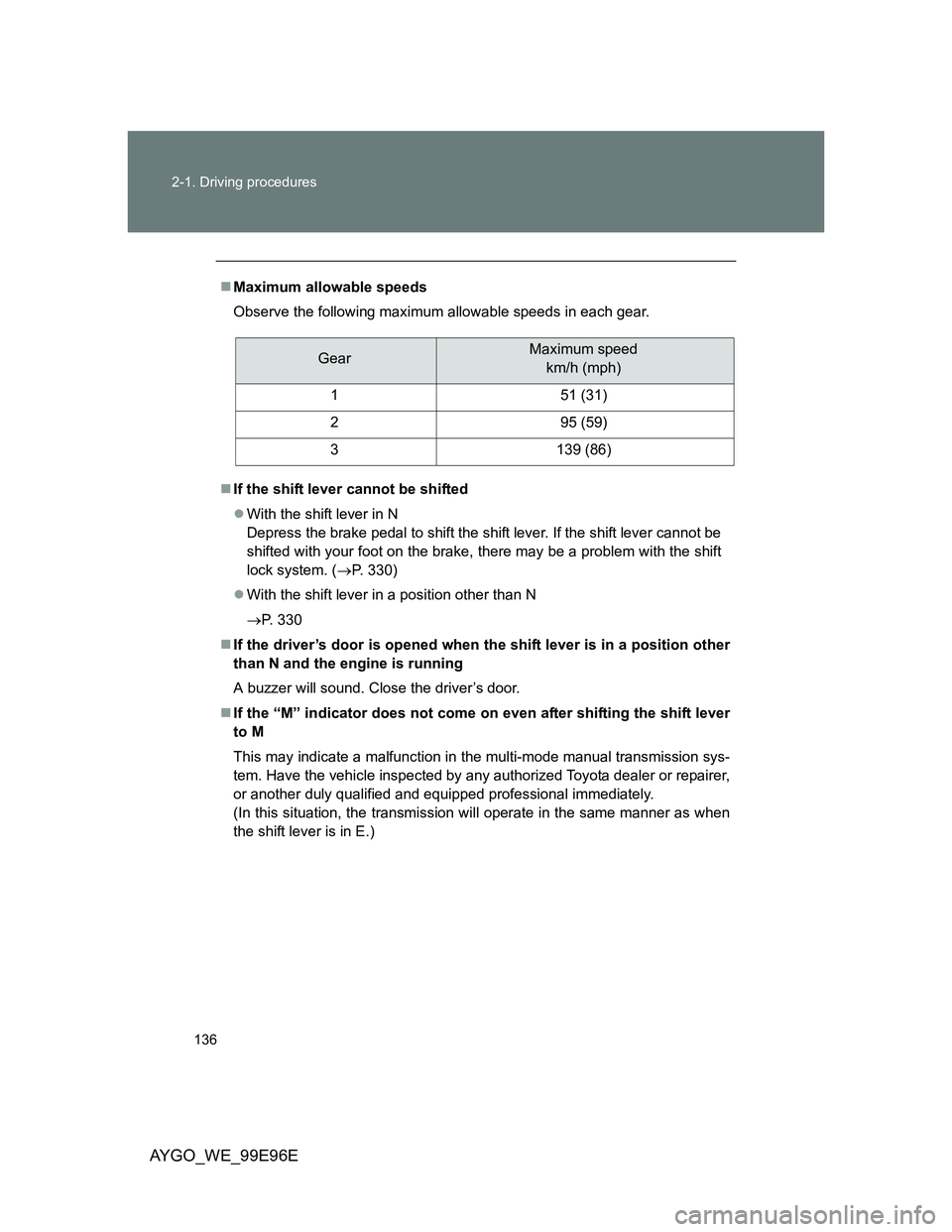
136 2-1. Driving procedures
AYGO_WE_99E96E
Maximum allowable speeds
Observe the following maximum allowable speeds in each gear.
If the shift lever cannot be shifted
With the shift lever in N
Depress the brake pedal to shift the shift lever. If the shift lever cannot be
shifted with your foot on the brake, there may be a problem with the shift
lock system. (P. 330)
With the shift lever in a position other than N
P. 330
If the driver’s door is opened when the shift lever is in a position other
than N and the engine is running
A buzzer will sound. Close the driver’s door.
If the “M” indicator does not come on even after shifting the shift lever
to M
This may indicate a malfunction in the multi-mode manual transmission sys-
tem. Have the vehicle inspected by any authorized Toyota dealer or repairer,
or another duly qualified and equipped professional immediately.
(In this situation, the transmission will operate in the same manner as when
the shift lever is in E.)
GearMaximum speed
km/h (mph)
1 51 (31)
2 95 (59)
3 139 (86)
Page 137 of 368

137 2-1. Driving procedures
2
When driving
AYGO_WE_99E96E
If the “N” indicator is flashing
When shifting the shift lever
Shift the shift lever to N. Wait a few seconds and shift the shift lever to the
desired position.
When the engine is turned off
Turn the engine switch to the “ON” position. Depress the brake pedal and
shift the shift lever to N, and then to the desired position.
If the indicator still flashes after the above operations, shift the shift lever to
N and start the engine. Then, shift the shift lever to the desired position.
Reverse warning buzzer
When shifting into R, a buzzer will sound to inform the driver that the shift
lever is in R.
Downshift restriction warning buzzer (in E mode [when the paddle shift
switches are operated] or M mode)
To help ensure safety and driving performance, downshifting operation may
sometimes be restricted. In some circumstances, downshifting may not be
possible even when the shift lever or paddle shift switches are operated. (A
buzzer will sound twice.)
Page 139 of 368
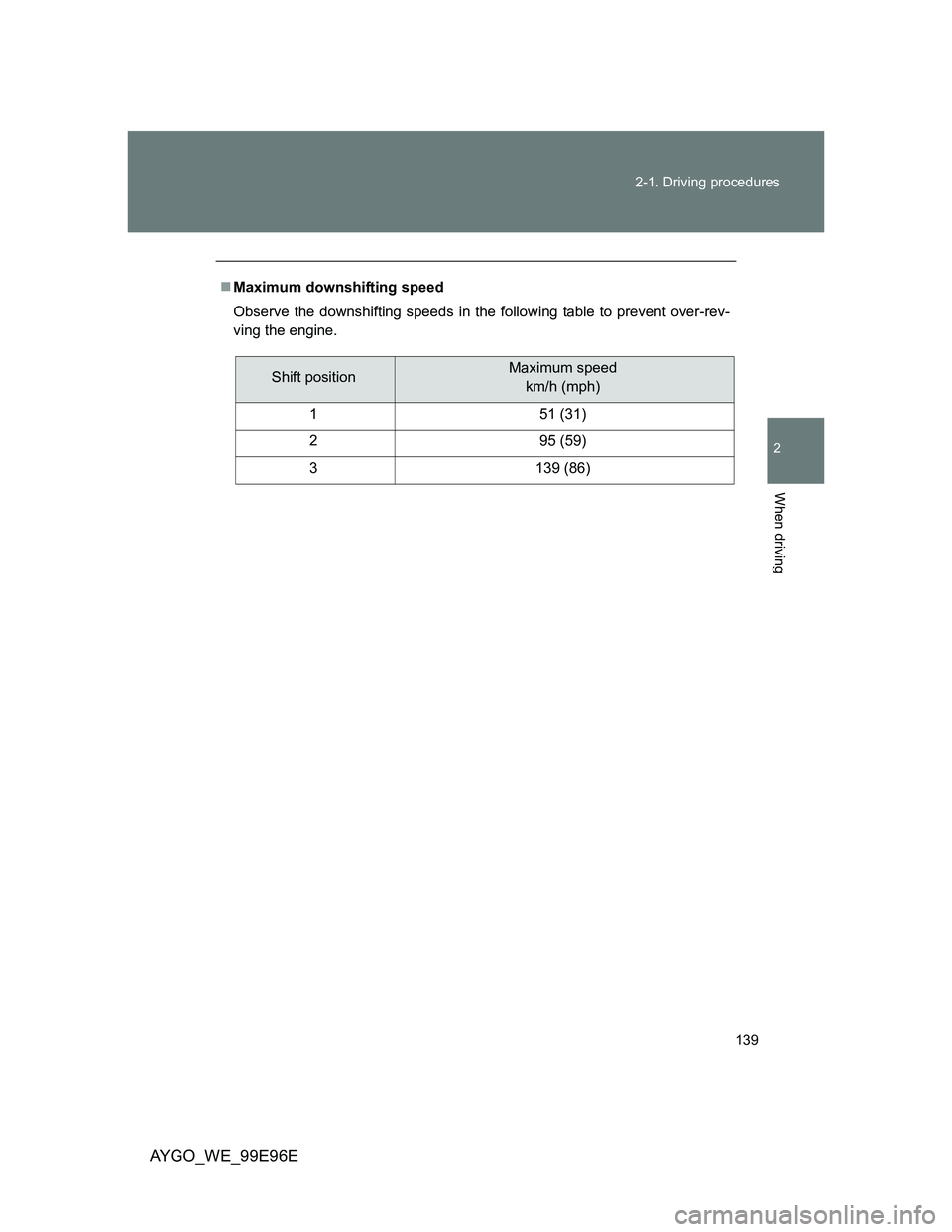
139 2-1. Driving procedures
2
When driving
AYGO_WE_99E96E
Maximum downshifting speed
Observe the downshifting speeds in the following table to prevent over-rev-
ving the engine.
Shift positionMaximum speed
km/h (mph)
1 51 (31)
2 95 (59)
3 139 (86)
Page 140 of 368

140
2-1. Driving procedures
AYGO_WE_99E96E
Turn signal lever
Turn signals can be operated when
The engine switch is in the “ON” position.
If the indicator flashes faster than usual
Check that a light bulb in the front or rear turn signal lights has not burned
out.
The turn signal lever can be used to show the following intentions
of the driver:
Right turn
Left turn
Lane change to the right
(push and hold the lever
partway)
The right hand signals will
flash until you release the
lever.
Lane change to the left
(push and hold the lever
partway)
The left hand signals will flash
until you release the lever.